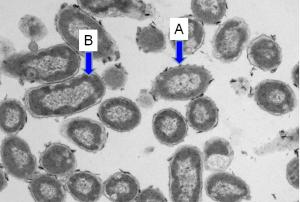Ozone nano-bubble water: a potential treatment for severe gum infections

Changes in the microstructure of bacterial cells exposed to NBW3 were assessed using a transmission electron micrograph (TEM). In Escherichia coli cells exposed to NBW3, disruption of the cell wall and the presence of numerous membrane vesicles projecting from the cell wall were observed (A). Moreover, coagulated materials were seen inside the treated cells, in particular, close to the cell membrane (B). However, there was no apparent lysis or gross leakage of cellular cytoplasmic contents from cells. In order to obtain a fuller understanding of the antibacterial mechanism of NBW3, further research is needed to determine how NBW3 damages the cellular structure and how this impacts cellular function.
The study published in the journal Science and Technology of Advanced Materials, by Shinichi Arakawa and colleagues at Tokyo Medical and Dental University and Japan's National Institute of Advanced Industrial Science and Technology, evaluated the bactericidal activities of ozone nano-bubble water – also known as NBW3 – against the two main bacterial agents that cause periodontitis as well as its toxicity to human oral tissue cells.
Their results showed that NBW3 can kill periodontal pathogens within 30 seconds of exposure, yet has only a minor impact on the viability of oral tissue cells after 24 hours of exposure.
Based on their in vitro results, the researchers conclude that NBW3 could become a valuable tool for treating periodontitis. However, since in vitro models cannot be directly compared to real-life clinical situations in which oral antiseptics are diluted with saliva, the authors recommend further research to determine the extent to which NBW3's potency may be reduced by the saliva of dental patients.
Periodontitis is an inflammation of the oral tissues that surround and support our teeth – it is caused by bacteria residing in “biofilms” or dental plaque.
The traditional first step of periodontal treatment involves “mechanical debridement” (i.e. scraping away the dental plaque and dental calculus). Various antiseptics and antibiotics have been used to supplement mechanical debridement.
But antibiotic therapies have several significant drawbacks, such as the selectivity of antimicrobial action, possible development of resistant bacteria, and risk for adverse host reactions. For these reasons, the topical use of a low-cost, broad-spectrum antiseptic agent with low potential for adverse reactions is preferable.
One possible alternative is ozone (O3), which has strong antimicrobial activity against bacteria, fungi, protozoa and viruses, and does not induce microbial resistance. Aqueous ozone is highly biocompatible with oral tissue cells. However, ozonated water must be used within the first 5 to 10 minutes after production to assure its potency.
To address this obstacle, co-author M. Takahashi and K. Chiba developed a patented procedure to produce ozone nano-bubble water. NBW3 retains its oxidation ability for more than six months if protected from exposure to ultraviolet rays. Its high stability allows for the bottling and use of NBW3 as a disinfectant solution.
For further information contact:
Shinichi Arakawa
Tokyo Medical and Dental University
Email: s-arakawa.ltoh@tmd.ac.jp
For more information about NBW3:
Masayoshi Takahashi
National Institute of Advanced Industrial Science and Technology (AIST)
Email: m.taka@aist.go.jp
Associated links
Journal information
Sae Hayakumo, Shinichi Arakawa, Masayoshi Takahashi, Keiko Kondo, Yoshihiro Mano and Yuichi Izumi: Sci. Technol. Adv. Mater. Vol. 15 (2014) p. 055003. DOI:10.1088/1468-6996/15/5/055003
Media Contact
More Information:
http://www.researchsea.comAll latest news from the category: Health and Medicine
This subject area encompasses research and studies in the field of human medicine.
Among the wide-ranging list of topics covered here are anesthesiology, anatomy, surgery, human genetics, hygiene and environmental medicine, internal medicine, neurology, pharmacology, physiology, urology and dental medicine.
Newest articles

Silicon Carbide Innovation Alliance to drive industrial-scale semiconductor work
Known for its ability to withstand extreme environments and high voltages, silicon carbide (SiC) is a semiconducting material made up of silicon and carbon atoms arranged into crystals that is…

New SPECT/CT technique shows impressive biomarker identification
…offers increased access for prostate cancer patients. A novel SPECT/CT acquisition method can accurately detect radiopharmaceutical biodistribution in a convenient manner for prostate cancer patients, opening the door for more…

How 3D printers can give robots a soft touch
Soft skin coverings and touch sensors have emerged as a promising feature for robots that are both safer and more intuitive for human interaction, but they are expensive and difficult…





















